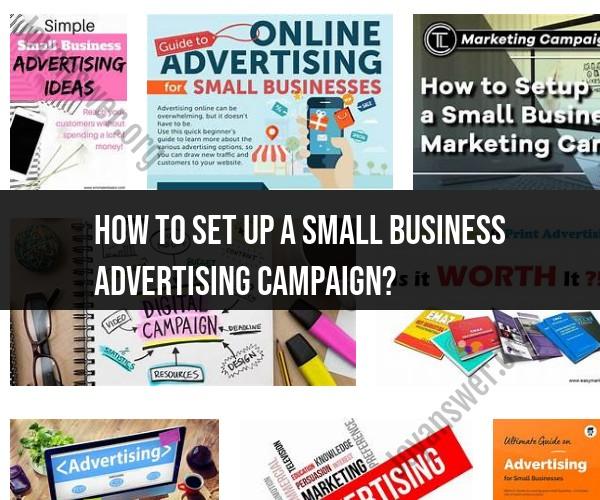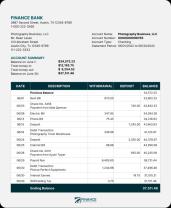How to set up a small business advertising campaign?
Setting up a successful advertising campaign for a small business involves careful planning and execution. Here are the steps to create an effective small business advertising campaign:
Define Your Goals and Objectives:
- Determine what you want to achieve with your advertising campaign. Are you looking to increase brand awareness, generate leads, boost sales, or promote a specific product or service?
Identify Your Target Audience:
- Clearly define your target audience, including demographic information, interests, and behavior. Understanding your audience helps you tailor your message effectively.
Choose the Right Advertising Channels:
- Select the advertising channels that align with your goals and target audience. Common options include online advertising (social media, Google Ads, display ads), print media, radio, television, and outdoor advertising.
Set a Budget:
- Determine how much you can allocate to your advertising campaign. Consider both the costs of creating ads and the media placement costs. Ensure your budget is realistic and manageable for your business.
Create Compelling Advertisements:
- Craft engaging and persuasive advertisements that resonate with your target audience. Your ads should highlight the unique selling points of your product or service and provide a clear call to action.
Choose the Right Keywords (for online advertising):
- If you're using online advertising, conduct keyword research to identify relevant keywords that potential customers might use to find your business. Use these keywords in your online ads.
Design Eye-Catching Visuals:
- For visual advertisements, invest in high-quality graphics, images, and videos. Visual content should be attention-grabbing and communicate your message effectively.
Plan Your Ad Schedule:
- Determine the timing and frequency of your ad placements. Consider when your target audience is most active and likely to engage with your ads.
Track and Measure Results:
- Use tracking tools and analytics to monitor the performance of your advertising campaign. Track metrics such as click-through rates, conversion rates, and return on investment (ROI).
Make Adjustments:
- Based on the data and insights you gather, make adjustments to your campaign as needed. If certain ads or channels are performing better, allocate more resources to them. Conversely, if something isn't working, consider making changes.
Test and Optimize:
- Continuously test different ad variations, headlines, visuals, and targeting options to optimize your campaign's performance. A/B testing can help you identify what resonates best with your audience.
Comply with Legal and Regulatory Requirements:
- Ensure that your advertising campaign complies with all legal and regulatory requirements in your industry and region. This includes disclosure of any disclaimers, adherence to privacy laws, and compliance with advertising standards.
Engage with Your Audience:
- Actively engage with your audience by responding to comments, messages, and inquiries related to your ads. Building a relationship with potential customers can enhance the effectiveness of your campaign.
Evaluate and Refine:
- After the campaign concludes, evaluate its overall performance against your initial goals. Use this information to refine your future advertising efforts.
Remember that successful advertising campaigns often require experimentation and adaptation. What works for one campaign may not work for another, so be prepared to iterate and refine your strategies to achieve the best results for your small business.
Launching a Small Business Advertising Campaign: Step-by-Step Guide
Launching a small business advertising campaign can be a daunting task, but it's essential for getting the word out about your business and attracting new customers. Here is a step-by-step guide to help you get started:
- Set your goals. What do you want to achieve with your advertising campaign? Do you want to increase brand awareness, drive traffic to your website, or generate leads or sales? Once you know your goals, you can develop a strategy to achieve them.
- Define your target audience. Who are you trying to reach with your advertising? Once you know your target audience, you can tailor your messaging and choose the right channels to reach them.
- Choose your advertising channels. There are many different advertising channels available, such as online advertising, social media marketing, print advertising, and radio and television advertising. Choose the channels that are most likely to reach your target audience.
- Set your budget. How much money are you willing to spend on your advertising campaign? It's important to set a budget before you start so that you can track your results and make adjustments as needed.
- Create your ad copy. Your ad copy should be clear, concise, and persuasive. It should highlight the benefits of your product or service and tell your target audience why they should choose you over your competitors.
- Design your ads. Your ads should be visually appealing and attention-grabbing. Use high-quality images and videos, and make sure your text is easy to read.
- Launch your campaign! Once you have created your ads and chosen your channels, you can launch your campaign. Be sure to track your results so that you can see what's working and what's not.
Creating a Winning Advertising Strategy for Your Small Business
A winning advertising strategy is tailored to your specific business goals and target audience. Here are some tips for creating a winning advertising strategy:
- Focus on your unique selling proposition. What makes your business different from the competition? Your advertising should focus on your unique selling proposition and why customers should choose you.
- Use strong calls to action. Tell your target audience what you want them to do, whether it's visiting your website, calling your store, or signing up for your email list.
- Test and measure your results. It's important to test different ad copy and channels to see what's working best. You can use tools like Google Analytics to track your website traffic and conversions.
Campaigning for Success: Structuring Your Small Business Advertising Efforts
The structure of your small business advertising campaign will vary depending on your budget, goals, and target audience. However, there are some general principles that you can follow:
- Start small and scale up. It's better to start with a small budget and scale up as you see results. This will help you to minimize your risk and make sure that you are getting the most out of your advertising investment.
- Use a mix of channels. Don't rely on just one advertising channel. Instead, use a mix of channels to reach your target audience where they are.
- Be consistent. Advertising is a marathon, not a sprint. It takes time to build brand awareness and generate leads and sales. Be consistent with your advertising efforts and you will eventually see results.
Launching a small business advertising campaign can be a lot of work, but it's worth it in the end. By following these tips, you can create a winning advertising campaign that will help you to achieve your business goals.













